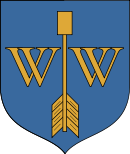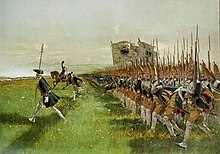Dobromierz
| Dobromierz | ||
|---|---|---|

|
|
|
| Basic data | ||
| State : | Poland | |
| Voivodeship : | Lower Silesia | |
| Powiat : | Świdnica | |
| Gmina : | Dobromierz | |
| Geographic location : | 50 ° 55 ' N , 16 ° 14' E | |
| Height : | 296 m npm | |
| Residents : | 847 (2011) | |
| Postal code : | 58-170 | |
| Telephone code : | (+48) 74 | |
| License plate : | DSW | |
| Economy and Transport | ||
| Street : | Jelenia Góra - Wroclaw | |
| Next international airport : | Wroclaw | |
| administration | ||
| Website : | www.dobromierz.pl | |
Dobromierz [ dɔˈbrɔmʲɛʃ ] (German Friedeberg , from the 18th century Hohenfriedeberg ) is a village in the powiat Świdnicki ( Schweidnitz district ) in the Polish Voivodeship of Lower Silesia . It is also the seat of the rural community Dobromierz .
The place name Hohenfriedeberg , which was valid until 1945 , was best known through the battle of Hohenfriedberg .
Geographical location
The village is located in Lower Silesia on the northern edge of the Waldenburger Bergland on the left bank of the Striegauer Wasser ( Strzegomka ) river.
Neighboring towns are Strzegom ( Striegau ) in the northeast, Olszany ( Oelse ) in the east, Świebodzice ( Freiburg in Silesia ) in the southeast, Cieszów ( Fröhlichsdorf ) in the south, Bolków ( Bolkenhain ) in the west and Bronów ( Börnchen ) and Roztoka ( Rohnstock ) in the northwest .
history


Probably before 1289 the Slavic predecessor settlement "Swenz" ( Shitzerland ) was implemented under German law by Duke Bolko I. For the year 1307 a pastor from "Vrideberch" is documented, which belonged to the Duchy of Schweidnitz . After the death of Duke Bolko II in 1368, this inheritance fell to the later Bohemian King Wenceslaus . He was the only son of the Bohemian Queen Anna von Schweidnitz , who died in 1362 before her childless Duke Bolko II. In 1409 King Wenzel Friedeberg granted city rights . It was owned by the (von) Bolze family until 1408, and then by Sander von Grunau. Around 1600 it belonged to the Zedlitz family , who presumably passed it on to the von Nimptsch family. In 1602 and again in 1683 Friedeberg was almost completely destroyed by a fire. In 1634 the parish church was rebuilt in stone at the expense of the lord of the neighboring Zeiskenburg , Nikolaus von Czettritz , out of gratitude that the city's citizens successfully granted him protection from the Swedes during the Thirty Years' War. Presumably at the beginning of the 18th century, the place name "Hohenfriedeberg" became common for Friedeberg. Around 1727, Christoph Ferdinand von Nimptsch had a baroque castle with a park built on the manor belonging to Shitzerland.
After the First Silesian War , Friedeberg fell to Prussia in 1742, like almost all of Silesia . In the same year, a house of prayer was built on the market square for the Protestant residents, who numbered two thirds of the population. Since 1789 Hohenfriedeberg was owned by Baron Carl von Seherr-Thoß . In 1811 the previous municipal school was converted into the town hall.
After the reorganization of the province of Silesia , the municipality of Hohenfriedeberg belonged to the Bolkenhain district from 1815 . With the support of the Prussian King Friedrich Wilhelm IV. , A memorial to commemorate the Battle of Hohenfriedberg was erected in 1847 on the Galgenberg, which was now known as the "Siegeshöhe" .
The economic importance of Hohenfriedeberg remained insignificant over the centuries, especially since it was repeatedly destroyed by fires. In 1852 the new road between Bolkenhain and Freiburg was opened. However, because it did not have a direct rail connection, it remained an insignificant artisan and arable town . In 1909 a new town hall with post office and police station was built. In 1932 the municipality of Hohenfriedeberg was incorporated into the Landeshut district , and in 1933 into the Jauer district , with which it remained connected until 1945.
The population rose from 454 in 1787 to 636 in 1825. After the incorporation of Shitzerland in 1905 706 inhabitants were counted and after the incorporation of Börnchen and Neu Petersdorf in 1939 there were 1074 inhabitants.
As a result of the Second World War , Hohenfriedeberg, like almost all of Silesia, was placed under Polish administration by the Soviet occupying power in 1945 . The German population was expelled in 1945/46 . Poles who had become homeless were settled here from the areas east of the Curzon Line that had fallen to the Soviet Union as part of the “ westward displacement of Poland ” . The once German city lost its city rights; the place name Hohenfriedeberg was initially translated into Górą Pokoju (also Wysoką Górą Pokoju , "High Peace Mountain "). It was not until 1948 that it was renamed Dobromierz , which is still valid today .
From 1975 to 1998 Dobromierz belonged to the Wałbrzych Voivodeship (German Waldenburg ).
Population development
| year | Residents | Remarks |
|---|---|---|
| 1933 | 659 | |
| 1939 | 1,095 |
coat of arms
The coat of arms of the current village Dobromierz was the former urban community Friedeberg in 1409 by Czech King Wenceslas IV. Bestowed that to the Duchy of Swidnica , one of the Friedeberg, 1468 as a Bohemian Erb had fallen principality. It shows the golden letters "WW" on a blue background with a blunt golden arrow in the middle.
Attractions
- The 13th century Catholic parish church of St. Michael was built of stone in 1634. From the Reformation until 1654 it served as a Protestant church.
- The hll. The church, consecrated to Petrus and Paulus, was built on the site of the former prayer house from 1742 according to plans by the architect Karl Friedrich Schinkel . Today it serves as a Catholic church.
- Family cemetery of the noble von Mutius family at the Michaelikirche. It is the only completely preserved private cemetery in Silesia.
- Hohenfriedeberg Palace was built in 1727 by Christoph Ferdinand von Nimptsch in the Baroque style and rebuilt in the second half of the 19th century.
- The baroque manor in the northeast of the castle was also built in the 18th century.
- Lookout tower / soldier monument on Siegeshöhe
Personalities
- Friedrich von Seherr and Thoß (1789–1857), Silesian officer, civil servant and manor owner
- Fedor Sommer (1864–1930), Silesian teacher, school councilor and writer
- Stanisław Szozda (1950–2013), Polish cyclist
literature
- Hugo Weczerka (Hrsg.): Handbook of the historical places . Volume: Silesia (= Kröner's pocket edition . Volume 316). Kröner, Stuttgart 1977, ISBN 3-520-31601-3 , pp. 194f.
- Dehio Handbook of Art Monuments in Poland. Silesia. Deutscher Kunstverlag, Munich et al. 2005, ISBN 3-422-03109-X , p. 267.
- Alexander von Freyer, Jauer and the Jauerland / Jawor i Ziemia Jaworska , Jawor 1995;
Web links
- Historical and current recordings
- Historical and current photographs of the von Mutius family cemetery
Individual evidence
- ^ CIS Census Poland March 31, 2011 r.
- ↑ http://www.territorial.de/ndschles/jauer/amtsbez.htm
- ↑ http://www.territorial.de/ndschles/landesh/amtsbez.htm
- ↑ http://www.territorial.de/ndschles/jauer/hohenfri.htm
- ↑ a b Michael Rademacher: German administrative history from the unification of the empire in 1871 to the reunification in 1990. jauer.html # ew39jaurhohenfrie. (Online material for the dissertation, Osnabrück 2006).




